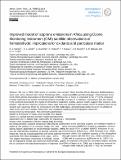Improved model of isoprene emissions in Africa using Ozone Monitoring Instrument (OMI) satellite observations of formaldehyde: implications for oxidants and particulate matter
Author
Guenther, A.
Kurosu, T. P.
Murphy, J. G.
Reeves, C. E.
Pye, H. O. T.
Published Version
https://doi.org/10.5194/acp-14-7693-2014Metadata
Show full item recordCitation
Marais, E. A., D. J. Jacob, A. Guenther, K. Chance, T. P. Kurosu, J. G. Murphy, C. E. Reeves, and H. O. T. Pye. 2014. “Improved Model of Isoprene Emissions in Africa Using Ozone Monitoring Instrument (OMI) Satellite Observations of Formaldehyde: Implications for Oxidants and Particulate Matter.” Atmospheric Chemistry and Physics 14 (15): 7693–7703. doi:10.5194/acp-14-7693-2014.Abstract
We use a 2005–2009 record of isoprene emissions over Africa derived from OMI satellite observations of formaldehyde (HCHO) to better understand the factors controlling isoprene emission on the scale of the continent and evaluate the impact of isoprene emissions on atmospheric composition in Africa. OMI-derived isoprene emissions show large seasonality over savannas driven by temperature and leaf area index (LAI), and much weaker seasonality over equatorial forests driven by temperature. The commonly used MEGAN (version 2.1) global isoprene emission model reproduces this seasonality but is biased high, particularly for equatorial forests, when compared to OMI and relaxed-eddy accumulation measurements. Isoprene emissions in MEGAN are computed as the product of an emission factor Eo, LAI, and activity factors dependent on environmental variables. We use the OMI-derived emissions to provide improved estimates of Eo that are in good agreement with direct leaf measurements from field campaigns (r = 0.55, bias = −19%). The largest downward corrections to MEGAN Eo values are for equatorial forests and semi-arid environments, and this is consistent with latitudinal transects of isoprene over West Africa from the AMMA aircraft campaign. Total emission of isoprene in Africa is estimated to be 77 Tg C a−1, compared to 104 Tg C a−1 in MEGAN. Simulations with the GEOS-Chem oxidant-aerosol model suggest that isoprene emissions increase mean surface ozone in West Africa by up to 8 ppbv, and particulate matter by up to 1.5 μg m−3, due to coupling with anthropogenic influences.Terms of Use
This article is made available under the terms and conditions applicable to Other Posted Material, as set forth at http://nrs.harvard.edu/urn-3:HUL.InstRepos:dash.current.terms-of-use#LAACitable link to this page
http://nrs.harvard.edu/urn-3:HUL.InstRepos:13956698
Collections
- FAS Scholarly Articles [18258]
Contact administrator regarding this item (to report mistakes or request changes)



